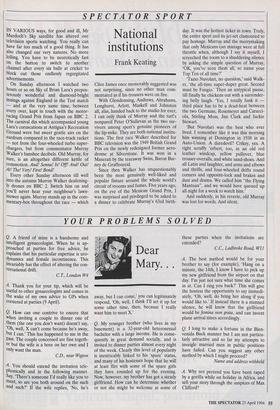SPECTATOR SPORT
National institutions
Frank Keating
IN VARIOUS ways, for good and ill, Mr Murdoch's Sky satellite has altered our television sports watching. You really can have far too much of a good thing. It has also changed our very natures. No more lolling. You have to be neurotically fast on the button to switch to another channel after every six balls at cricket to block out those endlessly regurgitated advertisements.
On Sunday afternoon I watched two hours or so on Sky of Brian Lara's prepos- terously wonderful and diamond-bright innings against England in the Test match — and at the very same time, between every over, kept in touch with the motor- racing Grand Prix from Japan on BBC 2. The carnival din which accompanied young Lara's coruscations at Antigua's Recreation Ground were but sweet gentle airs on the eardrum compared to the race-track racket — not from the four-wheeled turbo super- chargers, but from commentator Murray Walker's banshee decibels. Old Murray, for sure, is an altogether different kettle of commotion. And! Senna! Is! Off! And! Out! At! The! Very! First! Bend!
Every other Sunday afternoon till well into the autumn Murray Walker deafening- ly drones on BBC 2. Switch him on and you'll never hear your neighbour's lawn- mower again. Murray stands up in the com- mentary-box throughout the race — which Clive James once memorably suggested was not surprising, since no other man com- mentated as if his trousers were on fire.
With Glendenning, Andrews, Abrahams, Longhurst, Arlott, Maskell and Johnston all, alas, handed back to the studio for ever, I can only think of Murray and the turf's nonpareil Peter O'Sullevan as the two sur- vivors among sport's genuine pioneers of the lip-mike. They are both national institu- tions. The first race Walker described for BBC television was the 1949 British Grand Prix on the newly redesigned former aero- drome at Silverstone. It was won in a Maserati by the tearaway Swiss, Baron Bar- ney de Graffenreid. Since then Walker has unquestionably been the most genuinely well-liked and popular fixture around the whole world's circuit of vrooms and fumes. Five years ago, on the eve of the Mexican Grand Prix, I was surprised and privileged to be asked to a dinner to celebrate Murray's 63rd birth- day. It was the hottest ticket in town. Truly, the entire sport and its jet-set clamoured to pay homage. Murray and the merrymaking that only Mexicans can manage were at full throttle when, although I say it myself, I screeched the room to a shuddering silence by asking the simple question of Murray, `OK, you've seen them all, so name your Top Ten of all time?'
`Tazio Nuvolari, no question,' said Walk- er, 'the all-time super-duper great. Second must be Fangio.' Then an untypical pause, till finally he chickens out with a surrender- ing belly laugh. 'Yes, I totally funk it third place has to be a dead-heat between the two Germans, Rosemeyer and Caracci- ola, Stirling Moss, Jim Clark and Jackie Stewart.
`But Nuvolari was the best who ever lived. I remember like it was this morning him winning at Donington in 1938 in an Auto-Union. A daredevil? Crikey, yes. A right scruffy 'erbert, too, in an old red leather windcap, yellow pullover, blue trouser-overalls, and white sand-shoes. And all Latin and laughter, and arms and elbows and thrills, and four-wheeled drifts round corners and opposite-lock and brakes and dust and drama. We called him "the Flying Mantuan", and we would have queued up all night for a week to watch him.'
And suddenly, in his reverie, old Murray was lost for words. And silent.


























































 Previous page
Previous page